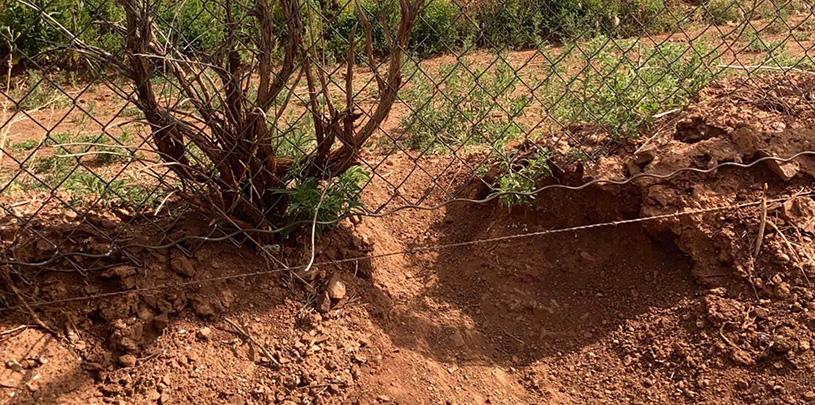
 by Audrey Kruse, Community Engagement Director
by Audrey Kruse, Community Engagement Director
As we walked along the chain-link fence surrounding a uranium mine near Grand Canyon National Park, I suddenly stopped short in my tracks. There in front of me was a sizable tunnel, approximately 18 inches in width and depth, excavated in the dirt under the fence. Tufts of tan fur stuck to the bottom rungs and paw prints littered the dusty soil in front of the tunnel. I sighed deeply, picturing the thirsty coyote who smelled the radioactive pond water on the inside of this fence and decided that digging underneath it was her best chance at sweet relief from the scorching Arizona sun.
The fence the clever coyote diligently perforated encloses a uranium mine situated about 10 miles south of the Grand Canyon’s south rim. Canyon Mine, owned by Energy Fuels Resources, has a mineshaft almost 1,500 feet deep. Since 2016, the mineshaft has been flooding with intercepted groundwater, despite assurances from the mining company that this would never happen (the company claimed that groundwater, if it was present at all, would be well below the deepest parts of the mine).
Once uranium ore is exposed to air, like has happened with the digging of Canyon Mine’s mineshaft, it becomes soluble in water. The company’s own testing shows that once in the mineshaft, the floodwater is radioactive, with uranium concentrations as high as four times the Environmental Protection Agency’s drinking water standards. Arsenic, another cancer-causing contaminant, is also found in the mineshaft water at levels 29 times the drinking water standard. This flooding necessitates perpetual pumping of the water into on-site holding ponds for evaporative disposal of the water.
In 2019 alone, over 10.5 million gallons of now-contaminated groundwater were pumped out of the mineshaft and into these holding ponds for evaporation, and inevitably, for occasional consumption by the local wildlife who find their way past the fence and into the uncovered pond.
Since the region’s groundwater flow is an unknown matrix of fissures and aquifers and an adequate groundwater monitoring system hasn’t been required at the mine, it’s impossible to definitively measure and manage the risk of contamination to the Grand Canyon’s seeps and springs emerging from groundwater aquifers below the mine.
The presence of the mine and its radioactive pond isn’t just an affront to the local wildlife. Its position at the foothills of Red Butte, one of the most sacred sites of the Havasupai people and a Traditional Cultural Property, plus the fact that water from the Redwall Muav Aquifer that lies beneath Canyon Mine feeds the majestic waterfalls of Havasu Creek on Havasupai land, makes the mine’s very existence a desecration of this landscape.

The radioactive-laden pond is the only reliable surface water in this arid area. A nearby stock tank, called Owl Tank, is sadly devoid of water most of the year.
Coyotes are not the only animals seeking an oasis in the desert. Trust staff document small mammal burrows under the fence on almost every visit to Canyon Mine. Water sprinklers, floating around the impoundment pond like watery Roombas, continuously mist the water into the air above the pond, supposedly to evaporate away the water and leave the heavier contaminants to sink to the bottom of the pond liner.
The day I saw the coyote tunnels, I also watched swallows swerve in and out of the water-sprayers and drink from the pond’s surface. A raven squawked and walked along the pond’s edge, glaring at me with his side-eye suspicion. As we turned to leave, I saw a delicate lavender butterfly dipping into the pond for a drink. This was all during a one-hour visit on a random weekday morning.

As soon as I returned from the visit, we filed a complaint with the regulatory agency that permits Canyon Mine’s operation. A few days later we received photos showing the coyote burrows had been plugged with gravel, something any self-respecting coyote would easily be able to re-excavate. The perpetual pumping of the groundwater and ongoing fence plugs to keep wildlife at bay show there are no quick fixes to the gaping hole that is Canyon Mine.
Take action. Urge Arizona regulators to close and clean up Canyon Mine.
A small victory in the legal case challenging Daneros uranium mine, near Bears Ears National Monument.
Read MoreGroundwater pumping at a uranium mine near the Grand Canyon will affect the canyon's springs, scientists says.
Read MoreA rally in Salt Lake City followed by a spiritual walk in White Mesa demonstrate the Ute community's determination to see uranium mill close.
Read More